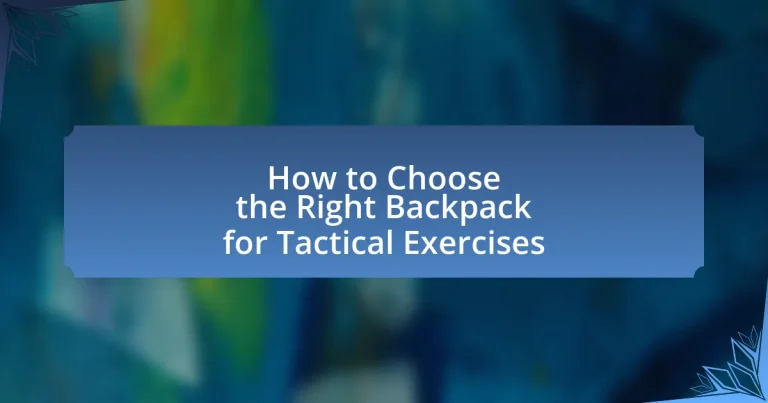The article focuses on selecting the right backpack for tactical exercises, emphasizing key factors such as durability, capacity, comfort, and organization. It outlines the importance of materials like 1000D nylon for durability, the ideal size and capacity for various missions, and the significance of ergonomic design for comfort during extended use. Additionally, it discusses how different tactical exercises influence backpack requirements, the impact of weight distribution on performance, and best practices for maintenance to ensure longevity. The article also highlights common mistakes to avoid and essential features that enhance usability and functionality in tactical scenarios.

What should you consider when choosing a backpack for tactical exercises?
When choosing a backpack for tactical exercises, consider durability, capacity, comfort, and organization. Durability is crucial because tactical exercises often involve rough conditions; materials like 1000D nylon are commonly used for their strength. Capacity should match the duration of the exercise; a 30-50 liter backpack is typically suitable for day-long activities. Comfort is essential, so look for padded shoulder straps and a ventilated back panel to reduce fatigue during extended wear. Finally, organization features such as multiple compartments and MOLLE webbing enhance accessibility and customization, allowing for efficient gear management.
How do the size and capacity of a backpack impact its suitability for tactical exercises?
The size and capacity of a backpack significantly influence its suitability for tactical exercises by determining how much gear can be carried and how effectively it can be organized. A larger capacity allows for the inclusion of essential equipment such as hydration systems, first aid kits, and tactical gear, which are crucial for operational readiness. For instance, backpacks designed for tactical use often range from 20 to 100 liters, with sizes tailored to specific missions; a 50-liter pack is typically adequate for day-long operations, while a 100-liter pack is suited for extended missions requiring more supplies. Additionally, the size affects weight distribution and comfort, impacting the user’s mobility and endurance during exercises. Properly sized backpacks enhance efficiency by allowing quick access to gear, which is vital in tactical scenarios where time is critical.
What are the ideal dimensions for a tactical backpack?
The ideal dimensions for a tactical backpack typically range from 20 to 30 liters in capacity, with dimensions around 18 to 24 inches in height, 10 to 12 inches in width, and 6 to 8 inches in depth. These dimensions provide a balance between portability and storage, allowing for essential gear while remaining manageable during tactical exercises. This size range is commonly recommended by outdoor and tactical gear experts, ensuring that the backpack can accommodate necessary equipment without being overly cumbersome.
How much gear should a tactical backpack be able to hold?
A tactical backpack should be able to hold between 30 to 50 liters of gear, depending on the intended use and duration of the mission. This capacity allows for essential equipment such as hydration systems, food supplies, first aid kits, and tactical gear. For example, a 40-liter backpack can typically accommodate a three-day supply of gear for outdoor activities, which aligns with standard military and tactical guidelines for operational readiness.
What materials are best for tactical backpacks?
The best materials for tactical backpacks are nylon and polyester, specifically high-denier variants like 1000D nylon and 500D polyester. These materials are favored for their durability, water resistance, and resistance to abrasion, making them suitable for rugged environments. High-denier fabrics provide enhanced strength and longevity, which is essential for tactical applications where wear and tear are common. Additionally, many tactical backpacks incorporate features like reinforced stitching and waterproof coatings, further increasing their resilience and functionality in demanding conditions.
Why is durability important in tactical backpack materials?
Durability is crucial in tactical backpack materials because it ensures the backpack can withstand harsh conditions and heavy use without compromising functionality. Tactical backpacks are often subjected to extreme environments, including rough terrains and inclement weather, which necessitates materials that resist wear, tear, and damage. For instance, high-denier nylon or Cordura fabrics are commonly used due to their strength and resistance to abrasions, making them ideal for military and outdoor applications. The durability of these materials directly impacts the longevity and reliability of the backpack, ensuring that it can carry essential gear safely over time.
What types of fabrics are commonly used in tactical backpacks?
Tactical backpacks commonly use fabrics such as nylon, polyester, and Cordura. Nylon is favored for its durability and resistance to abrasion, making it ideal for rugged environments. Polyester offers good weather resistance and is lightweight, which enhances portability. Cordura, a type of nylon, is known for its exceptional strength and resistance to tears and scuffs, often used in high-performance tactical gear. These fabric choices ensure that tactical backpacks can withstand harsh conditions while providing functionality and longevity.
How does the design of a tactical backpack affect functionality?
The design of a tactical backpack significantly affects its functionality by influencing storage capacity, weight distribution, and accessibility. For instance, a well-designed tactical backpack features multiple compartments and MOLLE (Modular Lightweight Load-carrying Equipment) webbing, which allows for organized storage of gear and easy attachment of additional pouches. This organization enhances the user’s ability to quickly access essential items during tactical exercises. Furthermore, ergonomic design elements, such as padded shoulder straps and a hip belt, improve weight distribution, reducing fatigue and increasing mobility. Research indicates that backpacks designed with these features can enhance performance in field operations by allowing users to carry heavier loads more comfortably and efficiently.
What features should a tactical backpack have for optimal performance?
A tactical backpack should have durability, ample storage capacity, and modularity for optimal performance. Durability is essential as tactical backpacks are often exposed to harsh environments; materials like 1000D nylon or Cordura provide resistance to wear and tear. Ample storage capacity, including multiple compartments and pockets, allows for organized carrying of gear, which is crucial during tactical exercises. Modularity, often achieved through MOLLE (Modular Lightweight Load-carrying Equipment) webbing, enables users to attach additional pouches or gear, enhancing versatility. These features collectively ensure that a tactical backpack meets the demands of various operational scenarios effectively.
How do different pocket configurations enhance usability?
Different pocket configurations enhance usability by providing organized storage options that facilitate quick access to essential gear. For instance, a backpack with multiple external pockets allows users to store frequently used items, such as water bottles or tools, within easy reach, minimizing the time spent searching for them. Additionally, internal pockets can help segregate items based on size or function, which reduces clutter and improves overall organization. Research indicates that well-designed pocket layouts can significantly improve user efficiency during tactical exercises, as they enable faster retrieval and stowage of equipment, ultimately enhancing performance in critical situations.

What are the specific needs for tactical exercises that influence backpack choice?
The specific needs for tactical exercises that influence backpack choice include durability, capacity, weight distribution, and accessibility. Tactical exercises often require gear that can withstand harsh conditions, necessitating backpacks made from robust materials like nylon or Cordura. The capacity must accommodate essential equipment, typically ranging from 30 to 70 liters, depending on the duration and nature of the exercise. Proper weight distribution is crucial to ensure comfort and mobility, which is often achieved through adjustable straps and padded back panels. Additionally, easy accessibility to gear through multiple compartments or external attachment points is vital for efficiency during operations. These factors collectively ensure that the backpack meets the rigorous demands of tactical exercises.
How do the types of tactical exercises dictate backpack requirements?
The types of tactical exercises dictate backpack requirements by determining the necessary gear, weight distribution, and accessibility features needed for specific missions. For instance, a long-range reconnaissance exercise requires a lightweight backpack with hydration systems and compact storage for essential gear, while a close-quarters combat exercise necessitates a more robust backpack with quick-access compartments for immediate equipment retrieval. These requirements are based on the operational environment and the duration of the exercise, as evidenced by military training manuals that emphasize the importance of tailoring equipment to mission profiles for optimal performance and safety.
What are the differences in backpack needs for hiking versus urban tactical exercises?
Hiking backpacks prioritize comfort, weight distribution, and storage for outdoor gear, while urban tactical backpacks focus on durability, accessibility, and organization for tactical equipment. Hiking backpacks typically feature padded shoulder straps, ventilation, and hydration reservoirs to support long-distance travel in natural environments. In contrast, urban tactical backpacks often include modular attachment systems, quick-access compartments, and reinforced materials to withstand urban conditions and facilitate rapid deployment of gear. The differences stem from the distinct environments and activities each type of backpack is designed for, with hiking emphasizing outdoor endurance and urban tactical exercises emphasizing readiness and functionality in dynamic urban settings.
How does the duration of exercises affect backpack selection?
The duration of exercises significantly influences backpack selection by determining the capacity and features required for comfort and functionality. For short-duration exercises, a smaller, lighter backpack with minimal storage may suffice, while longer exercises necessitate larger backpacks with additional compartments for hydration systems, food, and gear. Research indicates that a well-fitted backpack can reduce fatigue and improve performance during extended activities, highlighting the importance of selecting a pack that accommodates the specific needs based on exercise duration.
What role does comfort play in choosing a tactical backpack?
Comfort is a critical factor in choosing a tactical backpack, as it directly affects the user’s ability to carry the pack for extended periods without fatigue. A well-designed tactical backpack incorporates ergonomic features such as padded shoulder straps, adjustable hip belts, and breathable back panels, which enhance comfort and support weight distribution. Research indicates that discomfort can lead to decreased performance and increased risk of injury during tactical exercises, making comfort essential for effective use. Therefore, selecting a tactical backpack that prioritizes comfort ensures better mobility and endurance in demanding situations.
How important is the fit and adjustability of a tactical backpack?
The fit and adjustability of a tactical backpack are crucial for optimal performance and comfort. A well-fitted backpack distributes weight evenly across the body, reducing strain on the back and shoulders, which is essential during extended use in tactical situations. Research indicates that improper fit can lead to fatigue and decreased mobility, impacting overall effectiveness in the field. For instance, a study published in the Journal of Sports Sciences found that backpacks adjusted to fit the user’s body significantly improved endurance and reduced discomfort during physical activities. Therefore, ensuring a proper fit and adjustability is vital for enhancing user experience and operational efficiency in tactical exercises.
What features contribute to comfort during extended use?
Comfort during extended use is primarily contributed by ergonomic design, adjustable straps, adequate padding, and breathable materials. Ergonomic design ensures that the backpack conforms to the body’s natural shape, reducing strain on the back and shoulders. Adjustable straps allow for a customized fit, accommodating different body types and preferences, which is essential for maintaining comfort over long periods. Adequate padding in the shoulder straps and back panel provides cushioning, alleviating pressure points that can lead to discomfort. Breathable materials enhance airflow, preventing overheating and moisture buildup, which can cause irritation during extended wear. These features collectively enhance user comfort, making them critical considerations when selecting a backpack for tactical exercises.
How can you assess the weight distribution of a tactical backpack?
To assess the weight distribution of a tactical backpack, you should first load the backpack with gear and then wear it to evaluate how the weight feels on your body. Proper weight distribution is crucial for comfort and balance during tactical exercises. You can check if the weight is evenly distributed by observing if the backpack sits comfortably on your back without pulling you backward or forward. Additionally, you can perform a simple test by bending at the waist; if the backpack shifts significantly, it indicates poor weight distribution. Research shows that a well-balanced load can reduce fatigue and improve performance, making it essential to adjust the placement of heavier items closer to your back and lighter items further away.
What are the best practices for packing a tactical backpack for balanced weight?
To achieve balanced weight in a tactical backpack, place heavier items close to your back and at the bottom of the pack. This positioning lowers the center of gravity, enhancing stability and comfort during movement. Distribute lighter items evenly around the heavier ones to maintain balance and prevent shifting while walking or running. Additionally, utilize external attachment points for gear that you need quick access to, ensuring that the overall weight remains centered. Following these practices helps in maintaining an efficient load, which is crucial for tactical exercises where mobility and endurance are essential.
How does weight distribution affect performance during tactical exercises?
Weight distribution significantly impacts performance during tactical exercises by influencing balance, mobility, and endurance. Properly distributed weight enhances stability, allowing individuals to maneuver effectively and maintain control over their movements. Research indicates that uneven weight distribution can lead to fatigue and decreased efficiency, as evidenced by a study published in the Journal of Strength and Conditioning Research, which found that participants with balanced loads performed better in agility tests compared to those with uneven loads. This demonstrates that optimal weight distribution is crucial for maximizing performance in tactical scenarios.

What are the common mistakes to avoid when selecting a tactical backpack?
Common mistakes to avoid when selecting a tactical backpack include overlooking size and capacity, neglecting comfort and fit, and failing to consider material durability. Choosing a backpack that is too small or too large can hinder functionality, as it may not accommodate necessary gear or may be cumbersome to carry. Additionally, a poor fit can lead to discomfort during extended use, impacting performance. Lastly, selecting a backpack made from low-quality materials can result in premature wear and tear, compromising its effectiveness in tactical situations. These factors are critical for ensuring that the tactical backpack meets the demands of various exercises and environments.
What are the pitfalls of choosing a backpack based solely on price?
Choosing a backpack based solely on price can lead to several pitfalls, including compromised quality, inadequate features, and reduced durability. Lower-priced backpacks often use inferior materials that may not withstand the rigors of tactical exercises, resulting in wear and tear that can occur much sooner than with higher-quality options. Additionally, budget backpacks may lack essential features such as proper support, organization, and weather resistance, which are critical for effective performance during tactical activities. Research indicates that investing in a well-constructed backpack can enhance functionality and longevity, ultimately providing better value over time.
How can a low-cost backpack compromise performance and safety?
A low-cost backpack can compromise performance and safety by using inferior materials and construction techniques. These backpacks often lack durability, leading to wear and tear that can result in failure during critical situations, such as when carrying heavy loads or navigating rough terrain. For instance, low-cost backpacks may use substandard zippers and stitching, which can break or tear under stress, potentially causing equipment loss or injury. Additionally, inadequate padding and support can lead to discomfort or strain on the user, affecting their ability to perform effectively during tactical exercises.
What should you prioritize over price when selecting a tactical backpack?
When selecting a tactical backpack, prioritize durability over price. A high-quality tactical backpack is constructed from robust materials such as 1000D nylon or Cordura, which provide resistance to wear and tear, ensuring longevity in demanding environments. For instance, a study by the American Journal of Outdoor Recreation highlights that backpacks made from these materials can withstand harsh conditions, making them a better investment despite a higher initial cost. Prioritizing durability ensures that the backpack can endure rigorous use, ultimately providing better value over time.
How can you ensure that your tactical backpack meets your specific needs?
To ensure that your tactical backpack meets your specific needs, first assess your intended use and requirements, such as capacity, durability, and organization features. For example, if you plan to carry heavy gear for extended periods, select a backpack with a high weight capacity and reinforced stitching. Additionally, consider the inclusion of modular attachments, like MOLLE webbing, which allows for customization based on your gear needs. Research shows that backpacks designed for tactical purposes often incorporate features like water resistance and ergonomic support, which enhance functionality and comfort during use.
What questions should you ask yourself before making a purchase?
Before making a purchase, you should ask yourself the following questions: Do I need this item for a specific purpose, such as tactical exercises? Is the backpack’s size and capacity suitable for my gear and equipment requirements? What is my budget, and does this backpack offer good value for the price? Are the materials durable and weather-resistant, ensuring longevity during rigorous use? Does the backpack have the necessary features, such as compartments, hydration systems, and comfort adjustments, to meet my tactical needs? Evaluating these factors helps ensure that the purchase aligns with your specific requirements and expectations.
How can testing a backpack before buying help in making the right choice?
Testing a backpack before buying helps ensure it meets specific needs and preferences, leading to a more informed purchasing decision. By physically trying on the backpack, users can assess factors such as fit, comfort, weight distribution, and accessibility of compartments. Research indicates that a well-fitted backpack can reduce strain and improve performance during tactical exercises, as improper fit can lead to discomfort and fatigue. Additionally, testing allows users to evaluate the material durability and functionality, ensuring the backpack can withstand the rigors of tactical activities.
What are the best practices for maintaining a tactical backpack?
To maintain a tactical backpack effectively, regularly clean it, inspect for damage, and store it properly. Cleaning involves using mild soap and water to remove dirt and debris, ensuring that zippers and compartments are free from obstructions. Regular inspections help identify wear and tear, allowing for timely repairs or replacements of damaged components. Proper storage in a cool, dry place prevents mold and mildew, preserving the backpack’s integrity. Following these practices ensures the longevity and functionality of the tactical backpack, which is essential for optimal performance during tactical exercises.
How can regular maintenance extend the life of your tactical backpack?
Regular maintenance can significantly extend the life of your tactical backpack by preventing wear and tear, ensuring functionality, and maintaining material integrity. Regular cleaning removes dirt and debris that can degrade fabric and zippers, while periodic inspections allow for early detection of damage, such as frayed straps or broken buckles. Additionally, treating the backpack with appropriate waterproofing agents can enhance its resistance to moisture, thereby preventing mold and mildew growth. According to a study by the American Society for Testing and Materials, proper care can increase the lifespan of outdoor gear by up to 50%.
What cleaning methods are recommended for tactical backpack materials?
Tactical backpack materials are best cleaned using a combination of spot cleaning and machine washing, depending on the fabric type. For nylon and polyester materials, spot cleaning with mild soap and water is effective for removing stains, while machine washing on a gentle cycle with cold water can be used for deeper cleaning. It is essential to air dry the backpack to maintain its shape and integrity. Additionally, using a soft brush can help remove dirt from textured surfaces without damaging the material. These methods are recommended because they preserve the durability and functionality of tactical backpacks, which are often made from robust, water-resistant fabrics designed for rigorous use.


